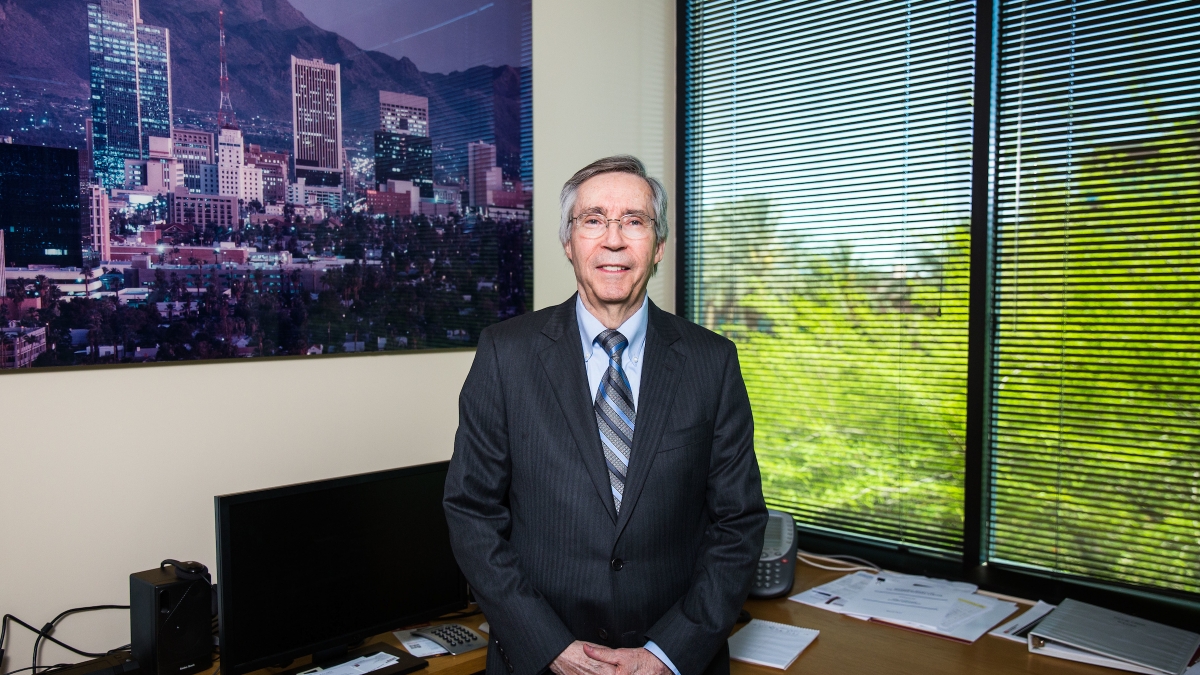No 'magic model' to drive growth, ASU jobs guru finds
Lee McPheters oversees one of the most comprehensive employment databases in the nation — and information is available to all

After decades of analyzing data on jobs, Lee McPheters knows this: There is no “magic model” to boost employment.
McPheters is the director of the JPMorgan Chase Economic Outlook Center at Arizona State University and has been studying the federal jobs report every month for more than 30 years.
Everyone is always interested in jobs — and no more so than during the 2016 presidential election, when Donald Trump campaigned on a promise to restore jobs.
McPheters, a professor of economics in the W. P. Carey School Business, said the center avoids politics and sticks to the numbers, which paint a complicated picture.
Consider Arizona and California, next-door neighbors that are mirror images. The states have the same job-growth rateNon-agricultural jobs are not included in this statistic. of 2.6 percent.
“Look at California — high taxes, high regulation. And it’s a state that’s losing domestic population,” he said.
“And then you have Arizona, where we try to control taxes and regulation and are a top-five destination for people to move to. You have two different philosophies and yet these states are tied.
“There’s just a lot going on other than what you see on the surface.”
McPheters runs one of the nation’s most comprehensive databases on employment, called Job Growth USA, with statistics on all 50 states, 380 cities and 50 occupations. Some of the information goes back to 1941, when Arizona had 106,000 jobs.
Every month, McPheters and his staff crunch a fresh set of numbers from the U.S. Bureau of Labor Statistics and keep their remarkable database up-to-the-minute accurate.
Want to know which metro area had the biggest increase in food-service jobs? Orlando, Florida — 11 percent more in February 2017 compared with last year.
Which metropolitan area just fell out of the top 10 for growth after six years? Denver.
And how is Arizona doing? In ninth place, our state moved into the top 10 for job creation in 2016 for the first time since 2013. Health care was the single largest source of growth, with 13,550 new jobs, 1 in 5 of the 68,000 jobs added in 2016 in Arizona.
McPheters’ latest report is good news for Arizona, which usually means a less intense focus on what he does. Everyone obsessed about jobs during the recession.
“When the economy is humming, people are not as concerned with what’s down because everything is up,” he said.
That’s where Arizona is right now.
“Growth is not as strong as we’ve seen in past recoveries, but we’re still a top-10 growth state,” he said. “We look at the parts of the economy that are doing well — health care, business and finance. That’s encouraging because those are knowledge-oriented jobs.”
McPheters has evaluated jobs data in the state and nation for more than 30 years.
And what about the minimum-wage increase? McPheters also evaluated the numbers for any effect from the voter initiative that raised the state’s minimum wage to $10 an hour in January, and found none.
“We looked at food-service job growth, since our analysis showed 75 percent of food-service workers would be affected,” he said. “Compared to past Januaries, this was the largest increase on record, with over 12,000 new food-service jobs added year on year.
“We’ll be watching this play out over the next few months, since this is the kind of state-wide laboratory experiment economists need to really understand the economy.”
The centerThe the JPMorgan Chase Economic Outlook Center is part of the Seidman Research Institute, a self-supporting unit in the W. P. Carey School of Business. just added a new feature to the site that shows the fastest-growing industry within any state, by percentage and numbers. In California, the job category “support activities for water transportation” was up 17 percent.
McPheters has seen the tiny ticks up and down every month over the years, and this makes him wary of big jumps.
“During the energy boom, North Dakota became the number one job-growth state, and we just knew that wasn’t going to last,” he said. “Fracking was a new industry. But the question was, is it sustainable? And it wasn’t. North Dakota is now losing jobsNorth Dakota was the top job-growth state from 2009 to 2014, and it was 50th in 2015 and 2016. The states losing jobs in the February 2017 report were Alaska, Kansas, Mississippi, North Dakota, Oklahoma, West Virginia and Wyoming..”
Besides Job Growth USA, the center also provides the Western Blue Chip Economic Forecast, on 12 Western states, and the Greater Phoenix Blue Chip Forecast. Both of those go beyond jobs, with information on retail sales, construction and wages. McPheters gives about 30 economic-forecast presentations a year for local businesses, government agencies and organizations.
Back in the 1980s and 1990s, the center published its reports on paper and sold subscriptions, which brought in about $50,000 a year.
“But we saw the writing on the wall that information wants to be free,” he said, and now the database on the website is available to anyone.
McPheters said the center’s work is significant because people love to compare states.
“I’ve found that having the rankings as an indicator of economic conditions is something people can really understand,” he said.
“It’s an important contribution to understanding the health of Arizona and other states.”
Top photo: Lee McPheters, director of the JPMorgan Chase Economic Outlook Center at Arizona State University (in his Tempe office Wednesday), said the center avoids politics and sticks to the jobs numbers, which paint a complicated picture. Photo by Deanna Dent/ASU Now
More Business and entrepreneurship

Thunderbird archives: These walls do talk
Editor’s note: This is part of a monthly series spotlighting special collections from ASU Library’s archives throughout 2024. At most universities, if you want to learn about their history, you must…

California roots, global impact: Thunderbird at ASU grad's journey in global management
Editor’s note: This story is part of a series of profiles of notable spring 2024 graduates. Lake Forest, California, native Kyle Kay was attracted to Thunderbird School of Global Management at…

ASU student entrepreneurs win cash investments for ventures at Demo Day
Several Arizona State University student entrepreneurs who won big cash investments for their ventures on Saturday expressed gratitude not only for the money but also the support they found in…
